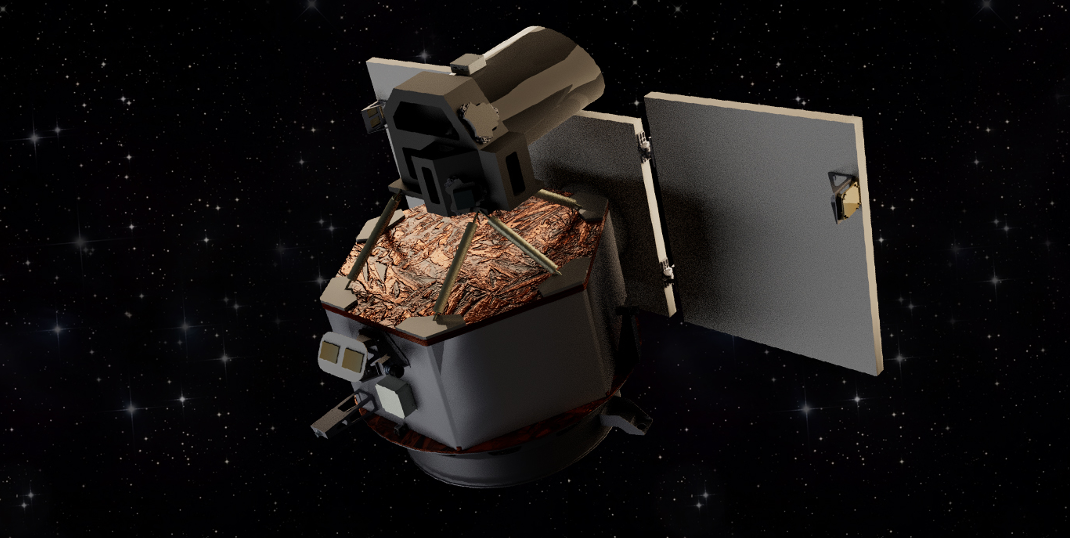Shining light on a solar blindspot
Proposed small explorer would capture polarized light to reconstruct Sun’s magnetic field
Nov 7, 2023 - by Laura Snider
Nov 7, 2023 - by Laura Snider

A rendering of what CMEx would look like in space.
A proposal for a spacecraft that would take a fresh look at the Sun — enabling a never-before-seen view of our star’s magnetic field — has received $2 million in funding from NASA for further study.
Development of the spacecraft, called the Chromospheric Magnetism Explorer, or CMEx, is being led by the U.S. National Science Foundation (NSF) National Center for Atmospheric Research (NCAR).
“Space weather, which can have profound effects on Earth, is driven by the Sun’s magnetic field,” said Holly Gilbert, who directs NCAR’s High Altitude Observatory and is the CMEx principal investigator. “To better predict solar storms and their likely impacts, we need a more complete understanding of the magnetic field in the Sun’s atmosphere. But this is a blind spot for today’s space-based observatories. Essentially, we are only able to measure the effects, not the cause.”
CMEx would change that, but it won’t be easy.
The mission team is interested in the magnetic fields in the chromosphere, a thin, low-lying layer of the Sun’s atmosphere that is sandwiched between the photosphere, or visible surface of the Sun, and the Sun’s extensive outer atmosphere, or Corona. Magnetic fields that form below the Sun’s surface extend upward through the chromosphere, twisting, tangling and releasing energy that then travels outward through the rest of the corona. This roiling magnetic activity makes the chromosphere a particularly interesting and important region to observe to better understand and predict space weather, which can occasionally damage satellites, disrupt radio communications and power grids, and endanger astronauts.
“Seeing” the magnetic structures, however, is tricky. The NCAR team is proposing to use a technique called spectro-polarimetry, a difficult undertaking that is mastered by relatively few scientists in the United States. Many of those with expertise happen to work at the High Altitude Observatory, making NCAR uniquely qualified to lead this kind of mission.
“This is something that has never been proposed before for a space mission,” Gilbert said. “The research community absolutely wants this, and we really need this information to make progress on predicting space weather, but it’s very challenging.”
Spectro-polarimetry builds on a much more common technique for gleaning information from the light emitted by stars known as spectrometry. As light passes through the Sun’s matter, the compounds within absorb and emit light at very specific wavelengths, leaving a unique spectral fingerprint in the light that continues on toward Earth. By breaking the incoming light from the Sun into its component wavelengths and looking to see where specific wavelengths are missing, scientists can learn an enormous amount about the Sun itself, including its composition, temperature, and density. The bunching, or stretching, of the fingerprint can even tell you how the plasma that forms the Sun flows and churns.
But the light from stars contains still more information that spectrometry is not able to identify on its own because some of the light is polarized. Magnetic fields interact with the light emitted by the Sun, leaving a signature of polarization across particular wavelengths. Spectro-polarimetry is the technique of extracting that information and using it to help reconstruct the structure of the magnetic field itself.
Spectro-polarimetry is difficult for a number of reasons, including that the polarized signal is quite weak against the flood of non-polarized sunlight. And telescopes used to observe the Sun can introduce their own polarization, further muddying the signal. Still, scientists at NCAR and elsewhere have shown that spectro-polarimeters deployed on Earth’s surface can produce valuable data.
For example, NCAR scientists designed an instrument called the Visible Spectro-Polarimeter, which is one of five instruments in NSF’s Inouye Solar Telescope. But ground-based spectro-polarimeters can only view the Sun for limited hours each day and they cannot observe the full range of wavelengths emitted by the Sun, some of which do not make it through Earth’s atmosphere.
The space-based spectro-polarimeter proposed for CMEx would be in low Earth orbit with an almost constant view of the Sun, allowing it to take nearly continuous observations. CMEx would also capture important wavelengths not possible from Earth and ultimately enable researchers to map the Sun’s magnetic structures in 3D.
The current funding from NASA will allow the NCAR team — along with its engineering partner, Ball Aerospace — to further develop the mission plan over the next nine months and demonstrate to NASA that they really can do the challenging work of actually processing the data they get back to draw out the magnetic structures.
If CMEx is successfully funded beyond these current conceptual studies, it would become the first Explorer-sized spacecraft mission led by NCAR, and it would also provide a rich opportunity for NCAR to train and develop the next generation of scientists adept at spectro-polarimetery. Even if the mission does not win funding from the current NASA round, the conceptual studies being undertaken will help build capacity in spectro-polarimetry and pave the way for future NCAR-led missions.
“We see CMEx as an opportunity to really develop this capability, especially in the United States,” Gilbert said. “We are excited to share what we know and to work with others to continue to advance this technique.”